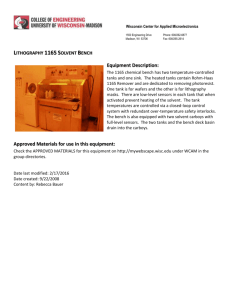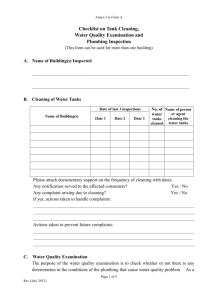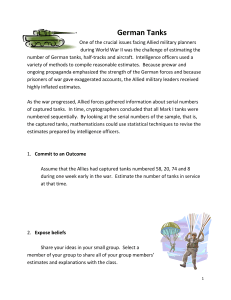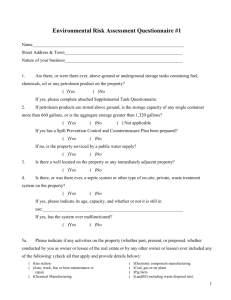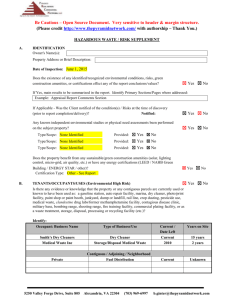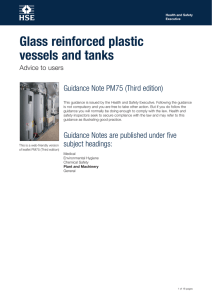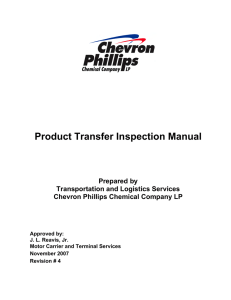Regulation DD-18.0 Fuel-Chemical Storage Tank Installation
advertisement
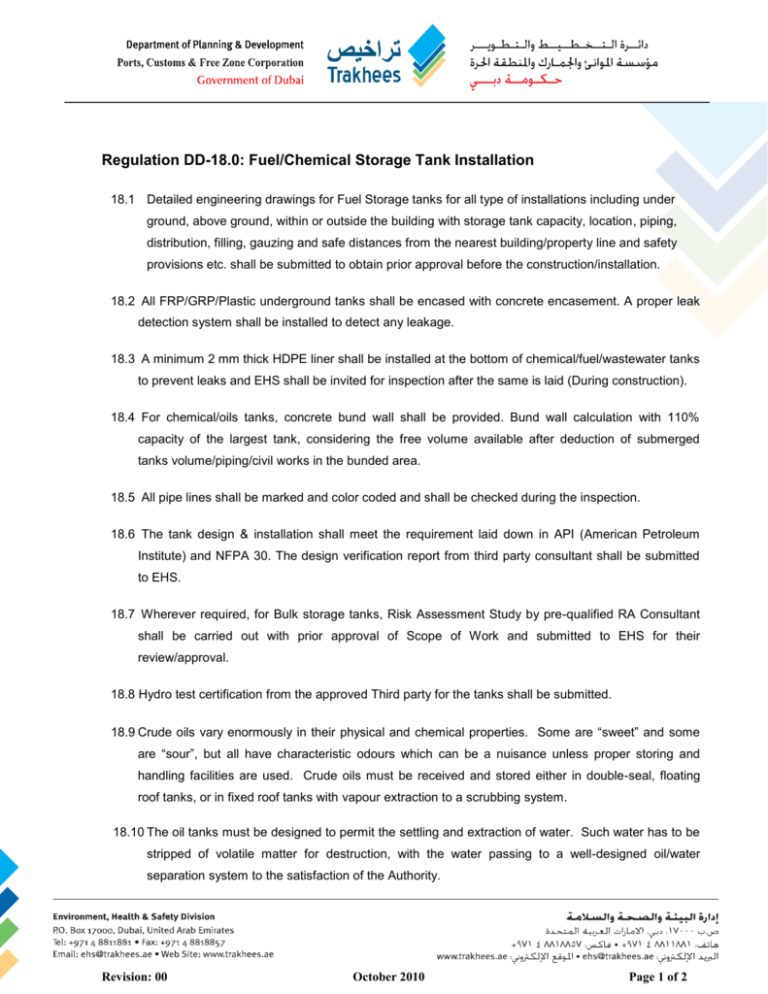
Regulation DD-18.0: Fuel/Chemical Storage Tank Installation 18.1 Detailed engineering drawings for Fuel Storage tanks for all type of installations including under ground, above ground, within or outside the building with storage tank capacity, location, piping, distribution, filling, gauzing and safe distances from the nearest building/property line and safety provisions etc. shall be submitted to obtain prior approval before the construction/installation. 18.2 All FRP/GRP/Plastic underground tanks shall be encased with concrete encasement. A proper leak detection system shall be installed to detect any leakage. 18.3 A minimum 2 mm thick HDPE liner shall be installed at the bottom of chemical/fuel/wastewater tanks to prevent leaks and EHS shall be invited for inspection after the same is laid (During construction). 18.4 For chemical/oils tanks, concrete bund wall shall be provided. Bund wall calculation with 110% capacity of the largest tank, considering the free volume available after deduction of submerged tanks volume/piping/civil works in the bunded area. 18.5 All pipe lines shall be marked and color coded and shall be checked during the inspection. 18.6 The tank design & installation shall meet the requirement laid down in API (American Petroleum Institute) and NFPA 30. The design verification report from third party consultant shall be submitted to EHS. 18.7 Wherever required, for Bulk storage tanks, Risk Assessment Study by pre-qualified RA Consultant shall be carried out with prior approval of Scope of Work and submitted to EHS for their review/approval. 18.8 Hydro test certification from the approved Third party for the tanks shall be submitted. 18.9 Crude oils vary enormously in their physical and chemical properties. Some are “sweet” and some are “sour”, but all have characteristic odours which can be a nuisance unless proper storing and handling facilities are used. Crude oils must be received and stored either in double-seal, floating roof tanks, or in fixed roof tanks with vapour extraction to a scrubbing system. 18.10 The oil tanks must be designed to permit the settling and extraction of water. Such water has to be stripped of volatile matter for destruction, with the water passing to a well-designed oil/water separation system to the satisfaction of the Authority. Revision: 00 October 2010 Page 1 of 2 18.11 The storage of volatile organic compounds with vapour pressures above 570mm mercury should be accompanied by a vapour recovery system. Below that vapour pressure, pressure/vacuum (P/V) ventilation valves should be fitted to storage tanks. In some cases it is practicable to install a floating, light metal sheet on the surface of the liquid to reduce evaporation. 18.12 All storage tanks must be adequately bunded to contain their contents in the event of a catastrophic leakage. The bunded area shall be sufficient to contain 110 percent of the volume of the largest tank within the bund. The floor shall consist of a good quality, impervious concrete with 2mm HDPE liner and Peak detection system is required. 18.13 The storage tanks for volatile organic compounds should ideally be of floating roofs with nitrogen blanketing. The vapors, upon filling, be recovered and routed to flare or recycled. 18.14 Periodic inspection/testing of the storage tanks shall be carried out to assess the Mechanical Integrity of the Vessel/Tank. An inspection program Risk-Based Inspection (RBI) is to be developed after systematic evaluation of both the likelihood of failure and the associated consequences of failure for each equipment. 18.14.1 External Inspection: A visual examination / evaluation of the exterior surface, structure, foundations and insulation of a pressure vessel or tank to determine the apparent condition and to establish the suitability of the vessel or tank for continued operation. 18.14.2 Internal Inspection: An examination / evaluation of the interior surface and structure of a vessel or tank using visual and / or non-destructive examination procedures to determine the physical conditions and to establish the suitability of the vessel or tank for continued operation. 18.14.3 On-Stream Inspection: An examination / evaluation performed from outside of a pressure vessel or tank using non-destructive examination procedures to determine the apparent condition and to establish the suitability of the vessel or tank for continued operation. 18.14.4 All the inspection/testing records and reports shall be maintained and will be required to be presented as & when required by the Authority. Revision: 00 October 2010 Page 2 of 2




